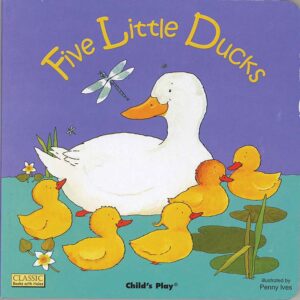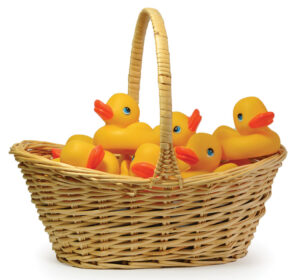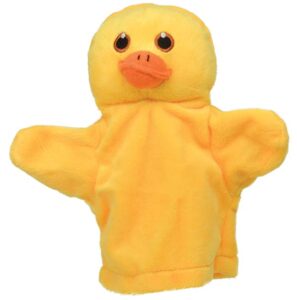Receptive language, Expressive language
Toddlers participate in a book sharing focused on little ducks who go away and come back.



[Invite several toddlers to join you to read a book. Show the cover of the book and point to the ducks as you describe them.]
 Our book is about a family of ducks. There are pictures of the ducks on the cover of our book. This is the mother duck. Do you see the little ducks? They are the mother duck’s babies.
Our book is about a family of ducks. There are pictures of the ducks on the cover of our book. This is the mother duck. Do you see the little ducks? They are the mother duck’s babies.
The little ducks go on a walk in our story. Where do we think the little ducks will go?
[Pause for toddlers to respond. Repeat and extend responses. Example: “You said ‘water,’ Jaylen. Ducks like to swim in the water! Let’s read our book to find out where the little ducks go.”]
[Use the following strategies to engage toddlers in the book:
The little ducks in our story went on a walk. They went far away! The mother duck called her little ducks. We helped the mother duck call her little ducks by saying “quack, quack, quack!” All the little ducks came back to the mother duck! Thank you for helping me read this story.
Toddlers will enjoy listening to the rhythmic, repetitive text of the book. The book’s richly-detailed illustrations also will appeal to many toddlers. It is not necessary or appropriate to emphasize the number of ducks on each page because toddlers are not expected to count. Instead, emphasize that the little ducks “go away” and then “come back.”
Extra support
Enrichment
Receptive language, Expressive language
Toddlers participate in a shared book reading followed by pretending to be little ducks in a key part of the story.



 Invite several toddlers to join you in reading a book together. Use strategies suggested in Option 1. Use a rhythmic, sing-song voice to emphasize text in which the little ducks go away and then come back.
Invite several toddlers to join you in reading a book together. Use strategies suggested in Option 1. Use a rhythmic, sing-song voice to emphasize text in which the little ducks go away and then come back.
At the conclusion of the book, invite the toddlers to pretend to be the little ducks in the story that go away and then come back. Give each toddler a rubber duck. You use the duck puppet as the mother duck. Show and explain to toddlers that your puppet is the mother duck.
Remind toddlers that the ducks went away. Use a hand/arm gesture to communicate “go away” over a hill. Encourage toddlers to hide their ducks. Offer several suggestions, such as toddlers putting their duck behind their back or using their other hand to cover their duck. Be flexible about how toddlers hide their duck.


Then remind toddlers that Mother Duck said “quack, quack, quack” and some ducks came back. Encourage toddlers to show their ducks. Offer a surprised face when the ducks come back!
Repeat this two-part activity several times if toddlers remain interested. Ignore the counting element of the story, where a certain number of ducks came back each time.
The follow-on activity uses two different prompts—go away and the “quack, quack, quack” call from Mother Duck to come back—to encourage toddlers to do two different actions: hide their ducks and then help their ducks come back. The activity promotes understanding of the go away and come back themes used repeatedly in the story. Toddlers will hide their ducks in a variety of ways, typically not recognizing that you can easily see their “hidden” duck. Remain flexible and accepting of toddlers’ actions with their ducks. Some toddlers may become overly excited during the activity and benefit from support to calm down, as suggested in the Extra Support tip.
As described in Option 1, toddlers are not expected to learn about numbers and counting.
Extra support
Enrichment
Receptive language, Expressive language
A toddler participates in a book sharing focused on looking at pictures to figure out what might happen next.



 Share Five Little Ducks with one toddler, using strategies suggested in Option 1. Draw attention to the interesting cutouts that provide clues about what happens on the next page. For the first several cutouts, point to and describe what you see and help the toddler connect the cutout images to what might happen next. Example: “Look at what is poking out of the water looking at the ducks. I see eyes and sharp teeth! What do you think it is?” Pause for the toddler to look closely at the cutout and respond. “Let’s turn the page to find out!” “It is a big fish!” Also, encourage the toddler to use his/her fingers to feel the cutouts.
Share Five Little Ducks with one toddler, using strategies suggested in Option 1. Draw attention to the interesting cutouts that provide clues about what happens on the next page. For the first several cutouts, point to and describe what you see and help the toddler connect the cutout images to what might happen next. Example: “Look at what is poking out of the water looking at the ducks. I see eyes and sharp teeth! What do you think it is?” Pause for the toddler to look closely at the cutout and respond. “Let’s turn the page to find out!” “It is a big fish!” Also, encourage the toddler to use his/her fingers to feel the cutouts.
After you use the first several cutouts to show how a cutout works in the story, point to a cutout and invite the toddler to tell what he/she sees. Talk with the toddler about what might happen next. Base your approach on the toddler’s emerging verbal skills and vocabulary knowledge. Remember that a toddler’s facial expressions, gestures, and finger pointing are important forms of communication, especially at this age. Describe what you see the toddler communicating.
The toddler may enjoy repeating some of the book’s words and phrases, consistent with opportunities suggested in Option 1.
Toddlers who are familiar with the story through participation in Option 1 or a related shared reading may find it easier to engage in Option 2. Familiarity with the story does not diminish the challenge of Option 2, however. The repeated use of cutouts to anticipate what happens next can promote valuable cognitive skills and strengthen story comprehension. It is not necessary to pursue cutouts with the same level of depth on each page. Give more attention to cutouts related to a toddler’s favorite part of the story.
Extra support
Enrichment
Materials needed: Five Little Ducks by Child’s Play, several rubber ducks, assortment of other pond animals (such as frogs, fish, or turtles), sensory table
Place the ducks and other pond animals in the sensory table with a small amount of warm water. Invite several toddlers to play with the animals in the water. Toddlers may enjoy hearing the book read while they interact with the ducks and animals. Encourage toddlers to have the pond animals go away to the other side of the sensory table, and then come back. Remind toddlers of how the little ducks went away and came back in our story.
Materials needed: Five Little Ducks by Child’s Play, Optional: duck puppet, rubber duck for each baby
Infants and older children can participate in Option 1 in meaningful ways. Infants may enjoy holding a rubber duck during the book sharing. Preschool-age children who are learning to count may wish to count the number of ducks on some of the pages. Older children may enjoy being the mother duck in Option 2.